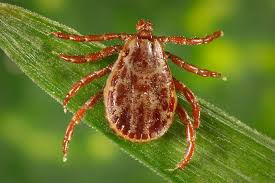It has taken just one bite of the Big Apple, and Asian long-horned ticks have gone from scientific surveillance to mainstream media headlines. These pesky ticks are not a new phenomenon in America, but are now being more closely watched by health authorities given the impact of Lyme disease in the US.
Asian Longhorned Ticks Are Not New
The species was first discovered feeding on some livestock in New Jersey two years ago. These arachnids apparently arrived in America without anyone knowing how they got here.
Slowly but surely the public has been notified of this potentially growing menace. On 31 May 2019, the journal Clinical Infectious Diseases published a report verifying the first identified human bite on American soil by an Asian long-horned tick. This has given momentum to calls by scientists to conduct more research on these ticks and the potential health risks.
Asian Longhorned Ticks and Lyme Disease

This is understandable. These ticks multiply at a rapid rate. Indeed, females can produce massive numbers of offspring without mating. They have also wreaked havoc in countries like New Zealand and Australia. They like to feed off livestock and have reduced production in dairy cattle by 25%
The bite took place in New York. The victim of the bite was a 66-year-old man. The tick found his victim in his backyard in a densely populated, suburban area. This is not the usual habitat for these ticks.
His doctor prescribed him a single 200-milligram dose of doxycycline thinking the bite came from a common black-legged tick.
The link to Lyme Disease
The man preserved the tick and took it to the Lyme Disease Diagnostic Center in Westchester, New York. They identified it as an Asian long-horned tick nymph. The tick was also sent for genetic sequencing at the National Veterinary Services Laboratory in Ames, Iowa. They ended up confirming the results.
Fortunately, three months later he remained unaffected by the bite. Asian long-horned ticks are known to harbor bacteria which causes human and animal diseases. This includes Lyme disease.
Authorities have been trying to work out where the tick came from. However, his only outdoor exposure 30 days prior to the bite took place on his lawn and one other lawn in the same area. The question of how the ticks got into this area remains unanswered.
Ticks On The Lawn in Direct Sun
The tick was not alone either. After authorities examined the yard in more detail, they discovered more Asian long-horned ticks on the patient’s manicured lawn and in direct sunlight. They also found more ticks in the park across the street from the patient’s house. In the open, cut grass which is exposed to the direct sun as well, as in taller, shaded grass next to the woods. Testing also found ticks on a nearby public trail, mowed short and mid-length grass near the trailing edge, both in full sun and partial shade. The discovery of ticks near the man’s house was the first known collection in New York state.

The report said it was significant that ticks were found on manicured lawns and in the open sun. Public education efforts may have to be revisited. These campaigns inform the black-legged tick —the most common biting tick in New York state— is mostly found in wooded areas or shaded grass.
Lyme Disease Claims Over 300 000 Victims in the U.S. Annually
Rick Ostfeld is a senior scientist at the Cary Institute of Ecosystem Studies in New York State and a tick specialist. He’s also the lead in a study on the spread of Lyme carrying ticks. Ostfield told reporters that Asian long-horned ticks have probably bitten humans in the U.S. before — but no one realized the bite came from a different species of tick.
So Now What?
Bobbi Pritt, MD, MSC, clinical microbiology at the Mayo Clinic in Rochester, Minnesota, wrote in an editorial that while the report of a human bite isn’t surprising, it is worrying.
“This is extremely worrisome for several reasons. One reason is that Asian long-horned ticks can carry several important human pathogens, including the potentially fatal severe fever with thrombocytopenia syndrome (SFTS) virus and Rickettsia japonica, which causes Japanese spotted fever.”
She says that while these pathogens have yet to be found in the United States, authorities must consider whether there is a risk to their future introduction.
Making Sense of Tick Risk
She says several other human pathogens have been found in the ticks, but it’s unclear if Asian long-horned ticks are able to transmit them to humans.
“It’s possible that the tick—known to be an aggressive biter—might be able to transmit Heartland virus, given its close relationship to SFTS virus.”
Pritt believes the invasive species are here to stay for the foreseeable future. The next steps should include public awareness campaigns that incorporate new information. This should include easy-to-use resources for labs to identify the tick, and more research to understand the implications of the new findings.
Need for More Public Awareness About Asian Longhorned Ticks
The Centers for Disease Control and Prevention assure it has been tracking the issue. Together with the U.S. Department of Agriculture, the Northeast Regional Center for Excellence in Vector-Borne Diseases at Rutgers University, and the state health department, they are investigating where and how widespread the tick is. And whether it can spread pathogens to animals and people in the United States.
Lars Eisen, a research entomologist with the CDC’s division of vector-borne diseases in Fort Collins, Colo., says research is ongoing to clarify the types of environments where you can be exposed to Asian long-horned ticks.
What does the CDC recommend?
For now, the CDC hasn’t changed its recommendations to prevent tick bites. Eisen assured the media this is based on most current information. The method that the CDC recommends preventing bites by other tick species is likely to be effective against Asian long-horned ticks too. This includes using EPA-registered repellents on skin and clothing and frequent tick checks soon after coming indoors “from potentially tick-infested areas, including your own backyard.”

Ostfeld believes too many new tick precautions may be in order given the improbable location of a human bite on a well-trimmed lawn in sunlight in suburbia. “We might want to expand the types of habitat that people have to be concerned about,” he says.
He’s also concerned about causing “tick fatigue”. You don’t want to “make your warnings so dire that people start to think they can’t do anything about it or avoid the out-of-doors altogether,” says Ostfeld.
Lyme disease is a growing concern
Lyme disease hotspots in the U.S. have risen from 69 in 1995 to 260 in 2012. At the same time, the range of ticks that transmit the disease has doubled. Lyme disease continues to spread due to expanding tick populations, climate change, and forest fragmentation. The disease is considered one of America’s most complicated public health crises.
Lyme disease can be difficult to diagnose and treat and has a profound impact on victims and their families. Treatment is also expensive. One study estimated that tick-borne illnesses cost the U.S. healthcare system up to $1.3 billion annually.
While some aspects of Lyme disease treatment are controversial, everyone agrees about the importance of disease prevention. No human vaccine is available, so it is important for people to reduce being exposure to infected ticks. Prevention is key.
The Tick Project is one such project. By understanding the ecology of Lyme disease scientists Rick Ostfeld and Felicia Keesing of Bard College hope to find a prevention method. They are leading this five-year study which aims to determine whether neighborhood-based prevention can reduce human cases of Lyme and other tick-borne diseases.
No Need To Panic
While authorities say there is no need to panic, they do expect to see more bites from Asian long-horned ticks. “The tick is known to bite people in other parts of the world, so the CDC expects to see occasional human bites in the United States as well.
What you should do if you think you have found Asian long-horned ticks in your yard?
- Remove any ticks from people and animals as quickly as possible.
- Preserve the ticks in a jar of alcohol or a sealed plastic bag, then:
- Refer to your health department about steps you can take to prevent tick bites and tick-borne diseases.
- You should get in contact with a veterinarian for information about how to protect pets from ticks and tick bites.
- It is also important to notify your state agriculture department or local agricultural extension office about ticks on livestock or for tick identification.
Protect Yourself. Your pets. Your Livestock
- The CDC and the Environmental Protection Agency offer recommendations about long-horned ticks and repellents.
- They suggest the use of the Environmental Protection Agency (EPA)-registered insect repellents. These repellents should contain DEET, picaridin, IR3535, oil of lemon eucalyptus, para-methanethiol, or 2-undecanone. Always follow product instructions.
- If you live in a high-risk area or are exposed to potential ticks then wear permethrin-treated clothing or other clothing that is equally protective
- Shower as soon as possible after spending time outdoors.

- Check for ticks daily. Ticks can hide under the armpits, behind your knees, in the hair, and in the groin.
- Tumble clothes in a dryer on high heat for 10 minutes. This will kill ticks on dry clothing after you come indoors.
- Treat pets and livestock for ticks with veterinarian-approved products.



![women [longevity live]](https://longevitylive.com/wp-content/uploads/2020/01/photo-of-women-walking-down-the-street-1116984-100x100.jpg)










